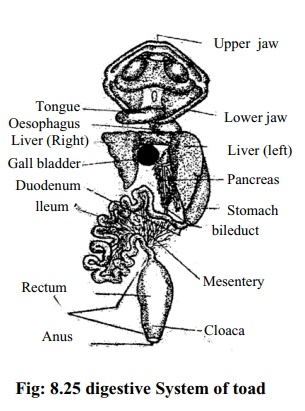Chapter: Biology: Structural Organization and Acquaintance of Animals
Toad: Digestive system

Digestive system:
The toad lives on worms, insects etc. The cells of the body cannot assimilate these food substances directly. Hence digestion of food material is required. The system which takes part to perform this work is called the digestive system. In other words, the system by which food is ingested, digested, absorbed and the undigested portion is ejaculated from the body as faeces are called the digestive system. Digestive system of the toad can be divided into two parts such as Alimentary canal and Digestive glands.

a. Alimentary Canal: The
canalextended from, the mouth opening to the cloacal aperture is called the
alimentary canal or gut. Sometimes this canal is narrow and sometimes it is
wide and coiled.
(i) Mouth: At the front end of the body of the toad the mouth or mouthopening is
situated. The mouth of the toad is quite wide and semicircular. There are two
jaws on the upper and lower sides of mouth. It cannont move the upper jaw, but
it can move the lower jaw. The jaws are toothless.
(ii) Buccal cavity: Behind
the mouth opening the wide buccal cavity is situated. On the lower side of the
buccal cavity lies the wide muscular tongue. Its front end is attached with the
lower jaw and the posterior end is free. Tongue is the main organ for capturing
prey. The toad catches worms and insects throwing the posterior part of the
sticky tongue in a reverse way and brings them directly into the mouth.
Internal nasal apertures, aperture of the eustachian tube etc. are situated
inside the buccal cavity.
(iii) Pharynx: The narrow extended part of the gut between the buccal cavityand
oesophagus is the pharynx.
(iv) Oesophagus: The stout, short and canal like part next to the pharynx is
theoesophagus. Through the oesophagus, food substances reach the stomach.
(v) Stomach: Behind the oesophagus the curved sac like part is the stomach. Itswall is
thick, muscular and glandular. The glands remain within the inner surface of
the wall. The stomach is divided into parts, cardiac and pyloric part.
Comparatively the thicker part which is close to the oesophagus, is the cardiac
part and the part which is close to the small intestine is the pyloric part of
stomach. There is a round muscular valve at the junction of the stomach and
intestine. It controls the entrance of food into the small intestine.
(vi) Intestine: The coiled duct extended from behind the stomach up to the cloacal aperture is the intestine. The
intestine is divided into two parts, Small intestine and Large intestine.
Small intestine: The narrow, coiled anterior part of the intestine behind thestomach is
the small intestine. The small intestine is again divided into two parts,
Duodenum and Ileum.
a. Duodenum: The first part of the small intestine which is like the English
letter 'U' is called the duodenum. The stomach and the duodenum remain
suspended in the body cavity by a thin transparent membrane called peritoneum.
The bileduct and the pancreaticduct together open into the duodenum.
b. Ileum: The second part of the duodenum is the ileum. This cannal
iscomparatively longer, narrower and more coiled. The inner walls of ileum bear
finger-like projections called villi and digested food materials are absorbed
through the surfaces of the villi.
Large intestine: Posterior to the small intestine, the comparatively thick part isthe
large intestine. It is divided into two parts, rectum and cloaca. In
the rectum, salts and vitamins are absorbed and the undigested part of the food
is stored here. No food material is digested here. Cloaca is the terminal part
of the large intestine. Here separately open the urinary duct and the
reproductive duct The cloaca opens outside through an opening called the
cloacal aperture. Through the cloacal aperture come out the faeces, urine and
the recrpoductive cells.
b. Digestive glands: The glands which secrete digestive juices and digestionand helps in the
digestive process are called the digestive glands. Toads have two main
digestive glands, Liver and Pancreas.
Liver: Liver is the largest gland of the body, located on either sides of
theheart. This gland is divided into two parts, right and left, which are connected
together by a middle part. Liver is a large chocolate or dark brown colour
gland. The gall bladder remains in the middle of the two parts. The bile
secreted from the liver is stored in this bladder. The functions of the liver
are
1.
Liver stores glycogen, fat and
vitamins. That is why it is called the store house of the body.
2. It assists in protein synthesis.
3. In the liver the nitrogenous excretory paroducts are transformed into
urea.
4. Red blood corpuscles originates in liver.
Pancreas: Pancreas is a very
important digestive gland
of the vertebrate animals. This gland is situated in
between the stomach and duodenum. It lookslike a leaf and is light yellow in
colour. The bile duct and the pancreatic duct join together to form
hepatopencreatic duct and open into the duodenum.
Related Topics